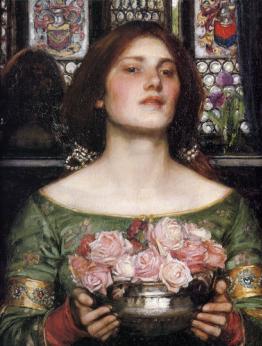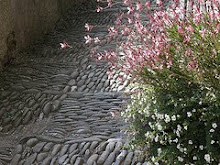 "In 'Rowans', placed against a colourful backdrop, two pretty young girls stand amid long grass each dressed in a bright coloured robe of vibrant blue and green, clutching a rich harvest of rowan berries. The simplicity of form, colour with the minimum of modelling and the two-dimensional quality of the inderterminate landscape reveals Henry's underlying feeling for Japanese design. The rosy innocence of the two girls is Victorian in essence and Henry's use of rowans not only as a strong focal point also carries a more symbolic message. In folklore, rowan trees protect from malignant spirits and all forms of psychic attack. The rowan is also a Druid tree, one of the holy trees of the ancient Celtic brotherhood of the forests; its turns away evil spirits. The form of symbolism springs more from earlier Pre-Raphaelite Brotherhood themes, seeking out mysticism and manifestations of the human soul in Nature." - from Sotheby's catalogue notes
"In 'Rowans', placed against a colourful backdrop, two pretty young girls stand amid long grass each dressed in a bright coloured robe of vibrant blue and green, clutching a rich harvest of rowan berries. The simplicity of form, colour with the minimum of modelling and the two-dimensional quality of the inderterminate landscape reveals Henry's underlying feeling for Japanese design. The rosy innocence of the two girls is Victorian in essence and Henry's use of rowans not only as a strong focal point also carries a more symbolic message. In folklore, rowan trees protect from malignant spirits and all forms of psychic attack. The rowan is also a Druid tree, one of the holy trees of the ancient Celtic brotherhood of the forests; its turns away evil spirits. The form of symbolism springs more from earlier Pre-Raphaelite Brotherhood themes, seeking out mysticism and manifestations of the human soul in Nature." - from Sotheby's catalogue notesFriday, November 6, 2009
George Henry - Rowans, 1895
 "In 'Rowans', placed against a colourful backdrop, two pretty young girls stand amid long grass each dressed in a bright coloured robe of vibrant blue and green, clutching a rich harvest of rowan berries. The simplicity of form, colour with the minimum of modelling and the two-dimensional quality of the inderterminate landscape reveals Henry's underlying feeling for Japanese design. The rosy innocence of the two girls is Victorian in essence and Henry's use of rowans not only as a strong focal point also carries a more symbolic message. In folklore, rowan trees protect from malignant spirits and all forms of psychic attack. The rowan is also a Druid tree, one of the holy trees of the ancient Celtic brotherhood of the forests; its turns away evil spirits. The form of symbolism springs more from earlier Pre-Raphaelite Brotherhood themes, seeking out mysticism and manifestations of the human soul in Nature." - from Sotheby's catalogue notes
"In 'Rowans', placed against a colourful backdrop, two pretty young girls stand amid long grass each dressed in a bright coloured robe of vibrant blue and green, clutching a rich harvest of rowan berries. The simplicity of form, colour with the minimum of modelling and the two-dimensional quality of the inderterminate landscape reveals Henry's underlying feeling for Japanese design. The rosy innocence of the two girls is Victorian in essence and Henry's use of rowans not only as a strong focal point also carries a more symbolic message. In folklore, rowan trees protect from malignant spirits and all forms of psychic attack. The rowan is also a Druid tree, one of the holy trees of the ancient Celtic brotherhood of the forests; its turns away evil spirits. The form of symbolism springs more from earlier Pre-Raphaelite Brotherhood themes, seeking out mysticism and manifestations of the human soul in Nature." - from Sotheby's catalogue notes
Subscribe to:
Post Comments (Atom)


























No comments:
Post a Comment